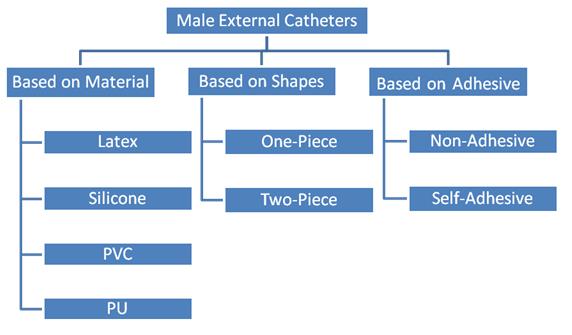Get 10% Off*, Use Code: HPDS25
Get 10% Off*, Use Code: HPDS25

 Reviewed by Christine Kijek, Registered Colorectal Nurse, on August 16, 2022
Reviewed by Christine Kijek, Registered Colorectal Nurse, on August 16, 2022
A male external catheter (MEC), also known as a condom catheter or Texas catheter, is used to treat urinary incontinence in men. It is a simple sheath that is worn on the penis, just like a condom. The end of the external urinary catheter is attached to a drainage tube that directs the urine flow into a drainage bag. Many people prefer condom catheters over indwelling catheters because indwelling catheters require insertion through the urethra. External catheter for men is very simple and easy to use, as it is just required to be rolled onto the penis.
Wondering what is the best male external catheter for you? Here is a list of different types of external catheters you can choose from.
There are different male external catheter types available. The main difference between them is based on the material, shape, and adhesive type.

Based on the material type, four male external catheters contain latex, silicone, polyvinyl chloride, and polyurethane.
Latex is a very soft, flexible, natural product. External condom catheters made of latex are easy to roll on the penis because of their flexibility. Also, they feel very soft against the skin.
Silicone is a translucent, breathable, and bio-compatible material. Silicone external urinary catheters can be a great alternative for those with latex allergies. They are skin-friendly, and their translucency allows the users to inspect the skin for any irritation or skin problems.
Polyvinyl chloride is a synthetic plastic polymer with resistant material that can stand against urine and mechanical impact. PVC catheters for men may have bio-hazardous effects in the long run.
Just like PVC, polyurethane is also a synthetic material. PU male catheters are thinner and provide more comfort as compared to other materials. Many of these types of external catheters are latex-free.
The male external catheters can be divided into one piece or two pieces on the basis of the shape of the catheters.
One-piece male external catheters constitute a single piece that must be pulled on. There is no need to struggle with wearing two or more pieces.
Two-piece external urinary catheters consist of two parts. One part is worn on the penis, and it remains there. The other part is a removable drainage tip connected to the drainage tube.
There are two types of external catheters based on the type of adhesive used, namely, non-adhesive external catheters and self-adhesive external catheters.
Non-adhesive external catheters do not contain any adhesive. They must be affixed to the penis with the help of skin glue, single or double-sided adhesive strips, or foam strips. Skin adhesives are applied before rolling on the catheter. Adhesive strips are encircled on the penis to attach the catheter. Reusable foam and elastic strips are used where there is a frequent need to replace the catheter.
Self-adhesive male external catheters have a sticky film on their inner surface which helps them attach to the penis. They are simply rolled up and pressed gently to fix them in place.
The penis's circumference must be measured for appropriate catheter sizing. The penis is measured at the shaft, whose diameter is the largest, to get the right size. The patient should sit on the edge of a bed or chair with a slight distance between the legs. In this position, the best measurement can be taken. There is no need to measure the length of the penis. Condom catheters usually fit most penis lengths, except when it is retracted or small.
If there is confusion between the two sizes, select the smaller one for better fit and leakage protection. The material of male external catheters is flexible and will snugly fit around the penis. The larger of the two sizes can result in leakage.

Health Products For You offers an array of urological supplies, including different types of external catheters. Here are three of our best condom catheters for you.
Disclaimer: All content found on our website, including images, videos, infographics and text were created solely for informational purposes. Our content should never be used for the purpose of diagnosis or treatment of any medical conditions. Content shared on our websites is not meant to be used as a substitute for advice from a certified medical professional. Reliance on the information provided on our website as a basis for patient treatment is solely at your own risk. We urge all our customers to always consult a physician or a certified medical professional before trying or using a new medical product.

Anushree Kothari, a family caregiver and a true empath, has been a devoted contributor to Health Products For You since 2016. Her journey as a medical writer for HPFY is a result ...
How To Increase Iron Levels Quickly
It’s a question that must have puzzled you like many others. Iron is essential in hemoglobin production and its inadequate levels can negatively impact your health. Dive into this informative article to explore top iron-rich foods that can help you fight iron deficiency.
10 Best Coccyx Cushions for Tailbone Pain
If you're like most people, you spend about 8 to 10 hours sitting every day. However unhealthy, it is part of life for many, and can cause tailbone pain. Coccyx cushions can help alleviate this pain. Click to read more and find the perfect coccyx cushion for your tailbone pain.
5+ Best Adult Diapers for Fecal Incontinence
Dealing with fecal incontinence can be challenging, but you're not alone. Read this article and navigate through discreet and effective solutions that help you manage fecal incontinence and let you live life on your terms with confidence and comfort.
Top 5 Best Reviewed Nebulizers of 2024
Need an effective and affordable nebulizer? Look no further, in this article we offer 5 of our best reviewed nebulizers that are loved by our customers. Click to read more and find the perfect nebulizer for all your respiratory needs.
10 Best Penis Pumps For Erectile Dysfunction
For anyone dealing with erectile dysfunction, penis pumps serve as a great way to manage it. But with so many products available, determining the best one for your needs can be challenging. To assist you in refining your choices and making an informed decision, here are our top 10 options, recognized for their effectiveness and safety.